This is our step-by-step guide on how to dehydrate jalapeno peppers. Dehydrated jalapeno peppers are a must-have for added zing and variety in our camping mealtime planning and preparation. They are also a necessity in our kitchen and prepper pantry.
Pickled jalapeno peppers are very easy to dehydrate in a food dehydrator. Similarly, they easily rehydrate as part of any recipe. Besides your homemade dehydrated camping meals, you can use them to augment your favorite store-bought freeze-dried food pouches.
We have found that dehydrated pickled jalapeno peppers will fully rehydrate in 10 to 15 minutes in either hot or cold water. So use them in your no-cook meal plans anytime you’re rushed for time or wish to go stoveless.
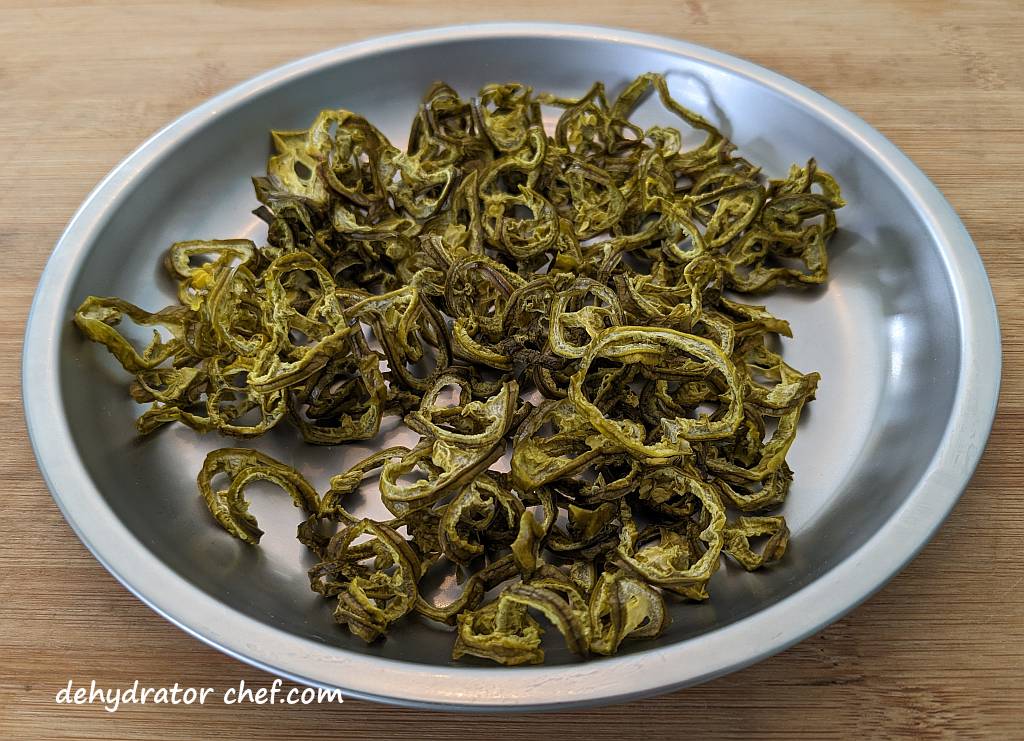
We do like our food spicy. I seem to go through a lot of these dehydrated jalapeno peppers for both day-to-day cooking and testing out our camping recipes before we get out in the field. So you should plan on making a big batch.
Besides spice and zing, jalapeno peppers also have numerous health benefits. They are a good source of vitamins A, C, B6, K, folate, manganese, and even a tad bit of fiber. Capsaicin, the spicy component of jalapeno peppers, also has many health benefits, such as boosting your metabolism and reducing appetite. So, this is all the more reason to add them to your outdoor meal plans.
So, let’s get started dehydrating jalapeno peppers.
Table of Contents
- How to Dehydrate Jalapeno Peppers
- Supplies Needed to Dehydrate Jalapeno Peppers
- Step 1. The Process to Dehydrate Jalapeno Peppers
- Step 2. Preparing the Dehydrator to Dehydrate Jalapeno Peppers
- Step 3. Dehydrating Pickled Jalapeno Peppers
- Step 4. When are the Dehydrated Jalapeno Peppers Done
- Step 5. Equalize and Condition the Dehydrated Jalapeno Peppers
- Step 6. Storing Dehydrated Pickled Jalapeno Peppers
- Hydration
- Weights, Measures, and Serving Sizes
- Insider Tips
How to Dehydrate Jalapeno Peppers
The best pickled jalapeno peppers for dehydration will have a minimal nutrition label ingredient list. So read that label. Stay away from brands that are high in sodium or contain questionable ingredients like food dyes.
Plan on buying a big jar; the dried jalapeno peppers will go fast once you start experimenting.
To dehydrate jalapeno peppers, you need only a good-quality food dehydrator. We use the Nesco dehydrators. Check out our food dehydrator guide to learn why we think Nesco offers the best bang for the buck.
Supplies Needed to Dehydrate Jalapeno Peppers
- Good quality pickled jalapeno pepper slices
- Food dehydrator
- Removable mesh inserts for the dehydrator trays, one for each tray
- Standard kitchen tools, including cutting boards, mesh strainer or colander, spatula, etc.
- Wide-mouth canning jar funnel
- Desiccant packets
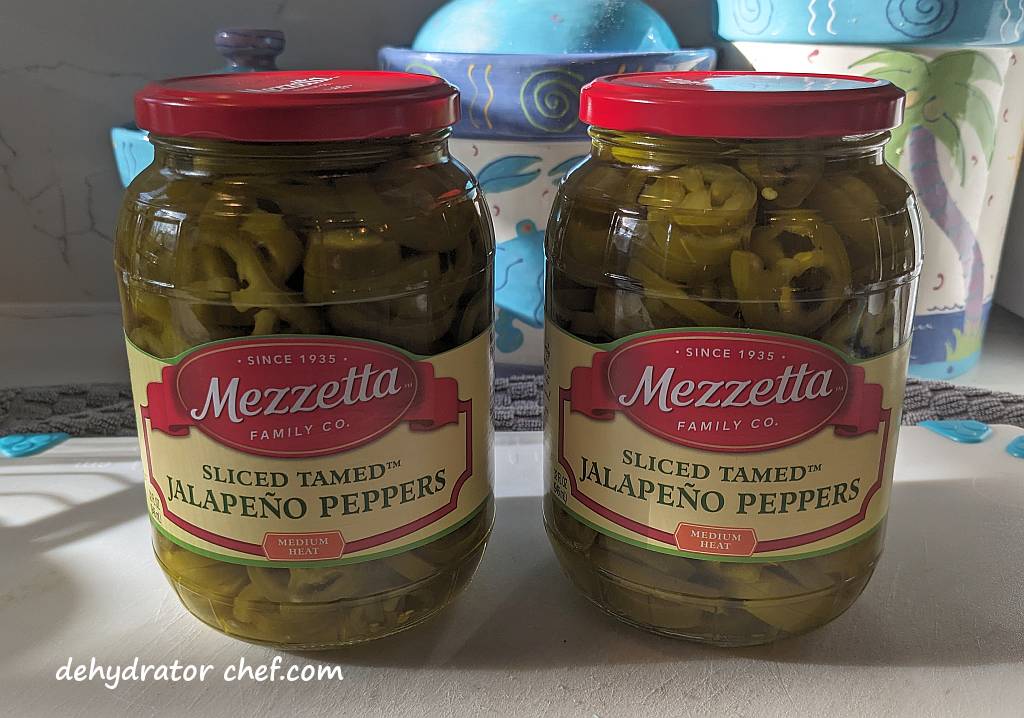
Step 1. The Process to Dehydrate Jalapeno Peppers
There isn’t much to do in the way of processing jarred jalapeno peppers for dehydration. Just drain the jar of its salty brine through a mesh strainer; that’s it. What we’re left with are yummy slices of pickled jalapeno pepper slices.

Consider saving that drained pickled jalapeno pepper brine in a canning jar. Use it in recipes that require a bit of added vinegar for a little extra zing.
Step 2. Preparing the Dehydrator to Dehydrate Jalapeno Peppers

For dehydrating our jalapeno peppers, we are using these removable Nesco Clean-A-Screen mesh screens for sticky fruits and small food items such as these pepper slices that we are dehydrating today. They have over 2500 customer reviews with an average rating of 4.7 stars out of 5, which is evidence of a great product.
Nesco Clean-A-Screens are removable and flexible mesh screen inserts with a distinct top and a bottom side. If you had a high-powered microscope, you would see the individual strands in the mesh screens have a triangle shape. The bottom side of the screen feels smooth. The top of the screen has a triangle point and feels rough as you rub your fingers across the mesh.
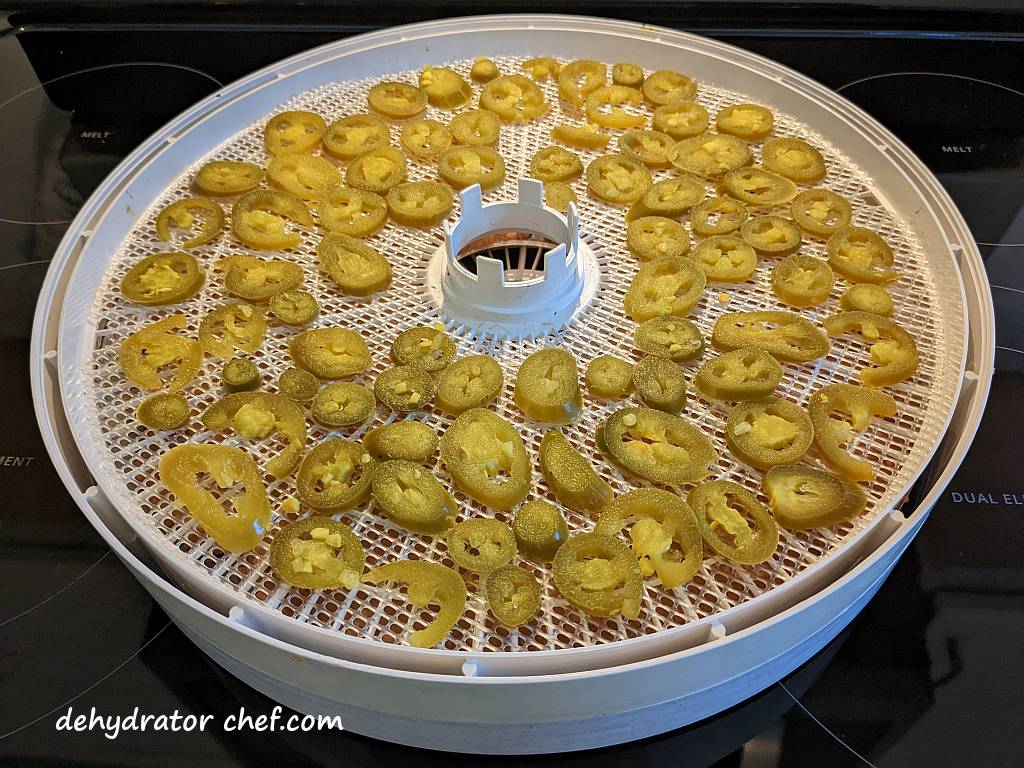
Next, layer the pickled jalapeno slices on the removable mesh screens. Discard any jalapeno slices with the woody stem still attached.
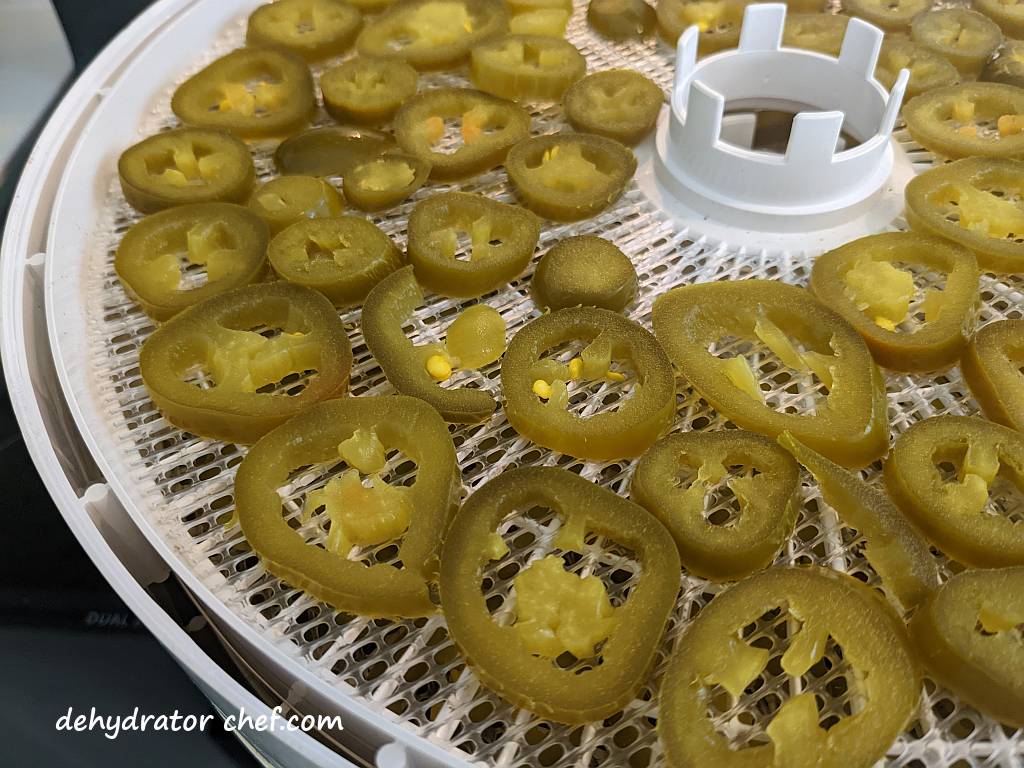
The Nesco 13.5-inch round dehydrator tray has close to 119 square inches or .8 square feet of surface area for drying.
For planning purposes, a 32-ounce jar of pickled jalapeno peppers will fill nearly 4 Nesco FD-61 13.5-inch round dehydrator trays.
Step 3. Dehydrating Pickled Jalapeno Peppers
To save time, you can start dehydrating the pickled jalapeno peppers by setting the drying temperature to 160 °F / 71 °C for 2 hours. Then dial the temperature back to 135 °F / 57 °C until dry, approximately 6 to 8 hours, depending upon the ambient temperature and humidity and how crowded you fill your trays.
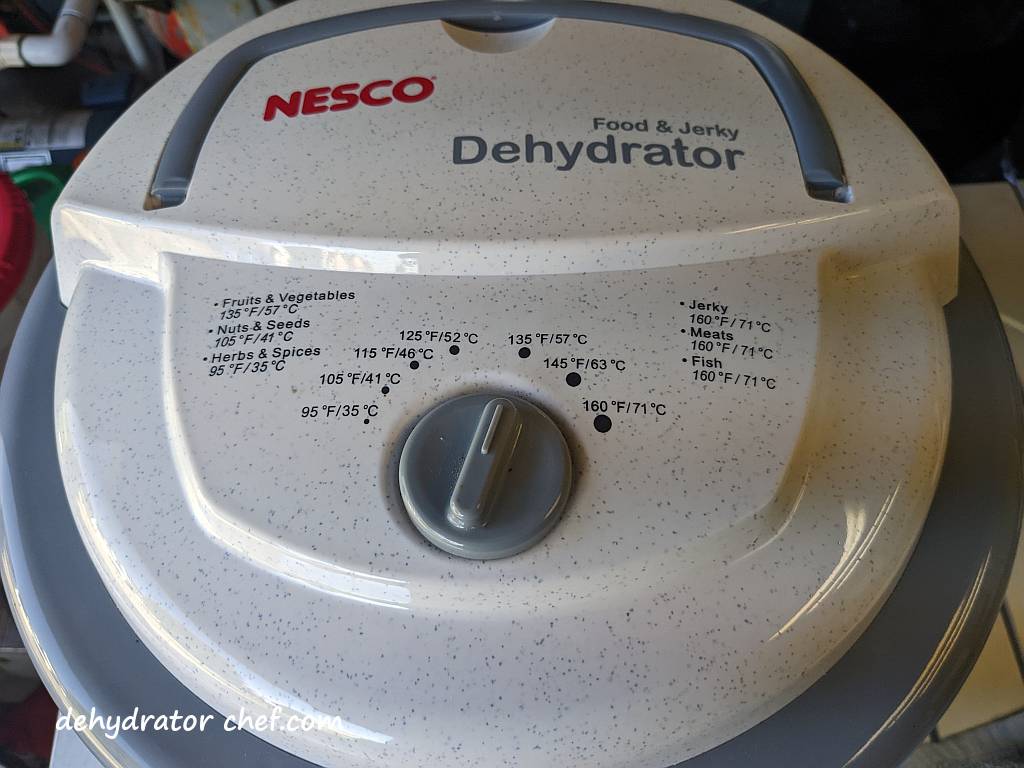
Step 4. When are the Dehydrated Jalapeno Peppers Done
Start checking for doneness in 6 hours. Fully dried jalapeno peppers will feel pliable while warm in the dehydrator. It’s best to remove the food dehydrator tray or unplug the dehydrator, then let it cool down a bit, and then recheck. Fully dried, the dehydrated jalapeno peppers will be crisp and easily break into pieces.
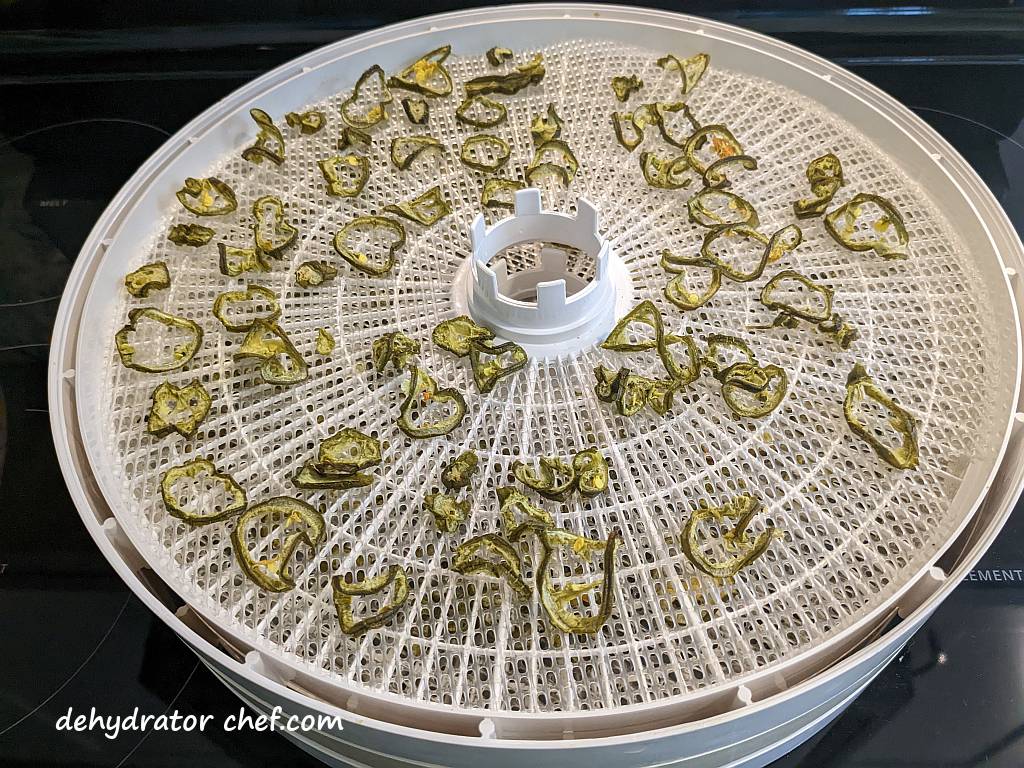
Drying times will vary depending on the dehydrator you own and the food you are dehydrating. Refer to your dehydrator owner’s manual for recommended temperatures and times for dehydrating specific foods. Remember to use drying times as a guide.
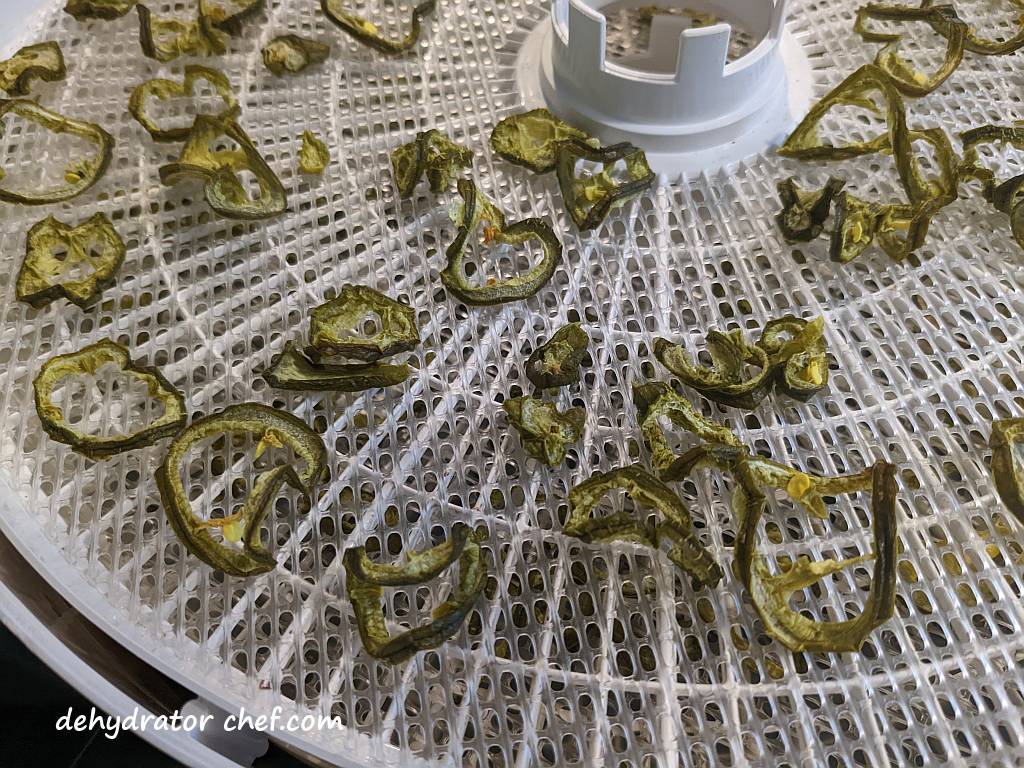
Step 5. Equalize and Condition the Dehydrated Jalapeno Peppers
We always recommend letting food items cool completely after they have finished dehydrating and before packing them into an airtight storage container. Warm food may cause sweating which could provide enough moisture for mold to grow.
It does not take long for dehydrated food items to start hydrating from naturally occurring household humidity. Do not leave dehydrated food items exposed to the elements any longer than necessary because of the increased risk of mold growth.
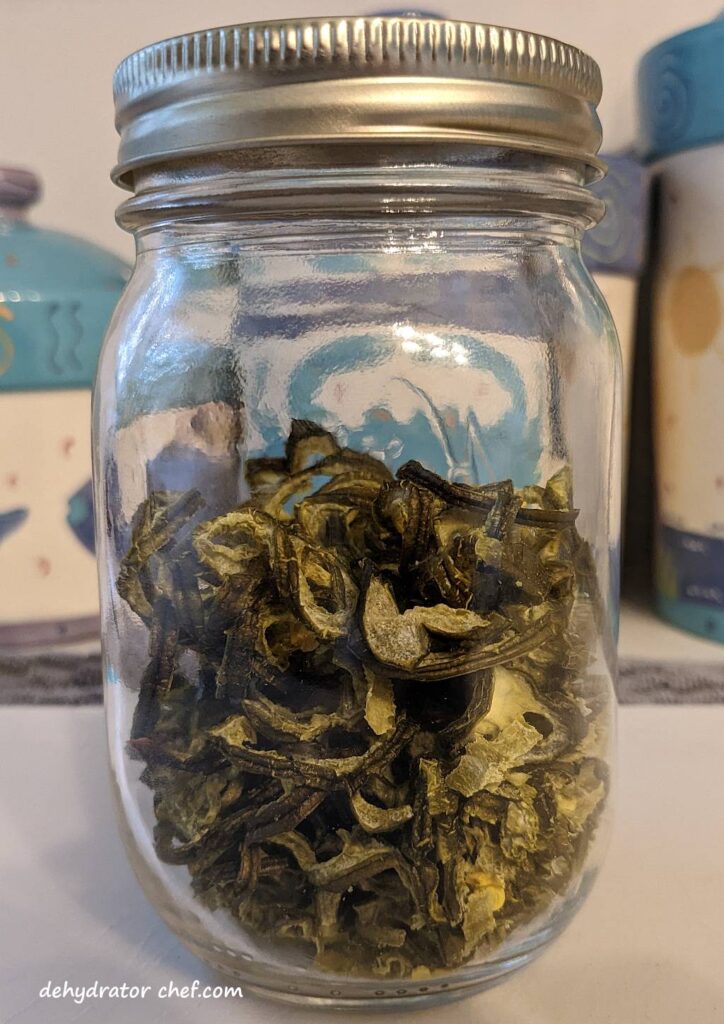
After a short cooling period, pack the dehydrated pickled jalapeno peppers into clean, dry, insect-proof containers with tight-fitting lids. We use clear canning jars for this task.
When the dehydrated pickled jalapeno peppers are removed from the dehydrator, the remaining moisture may not be distributed equally among the dried pepper slices because of their size, location, and position in the dehydrator. Equalizing and conditioning is a procedure used to equalize moisture among dehydrated food items and reduce the risk of mold growth. Let the dehydrated jalapeno peppers equalize and condition in the temporary storage container for 7 to 10 days.
A quality stainless steel or plastic canning funnel makes the messy job of getting dehydrated foods off the dehydrator tray removable inserts and into the canning jars an easy task. Take a minute or two and check them out here on Amazon.
Every day, check the jar for moisture. Roll the jar contents around and note any clumping or sticking. If seen, put the contents back on the dehydrator for several more hours. Since canning jars are clear, it’s easy to see what’s inside.
Step 6. Storing Dehydrated Pickled Jalapeno Peppers
Regardless of the type of storage container, it must be air-tight with a tight-fitting lid.
My preferred means of longer-term storage of dehydrated jalapeno peppers are canning jars with tight-fitting lids and a desiccant packet used for moisture control because we live in a fairly humid area.
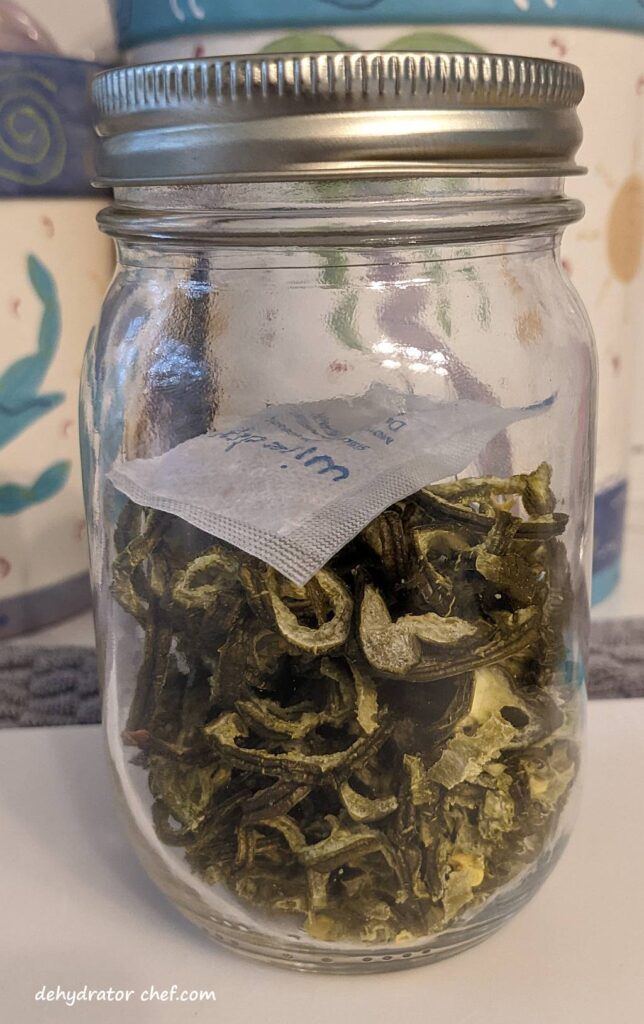
We use these inexpensive food-safe desiccant packets, which are available from Amazon. These 5-gram packets have over 5000 of mostly 4- and 5-star customer reviews, with an average of 4.7 stars out of 5. Our bag of 60 desiccant packets will last quite a while because they can be recharged and reused multiple times. Other food-safe sizes are available.

Do not leave your dehydrated food items exposed and unprotected any longer than necessary for the task at hand. It does not take long for dehydrated food items to naturally start hydrating from ambient household humidity. As such, this will increase the risk of mold growth.
Attach or include a short note describing the contents and the date the product was dehydrated. The note also informs us where to go in the dehydrator logbook to make another note.
Hydration
Hydrate the pickled jalapeno peppers using a 1-to-1 ratio of dehydrated peppers to water.
We have used both cold water and hot water to hydrate. Plan on 10 to 15 minutes to fully hydrate.
If you’re supplementing a freeze-dried as we do, just add a bit more boiling water to the pouch. Use the same 1-to-1 ratio of dehydrated peppers to water.
Weights, Measures, and Serving Sizes
This information is summarized from the notes we keep on about our food dehydration efforts.
A 32-ounce jar of sliced jalapeno peppers, drained, weighs approximately 450 grams.
The 32-ounce jar label nutrition facts showed the serving size is 1/4 cup (30 grams). Note: this is the drained weight.
The 450 grams of pickled jalapeno peppers dehydrate to 38 grams.
38 grams dehydrated weight / 14 servings = 2.7 grams. Rounded up to 3 grams.
Insider Tips
Add dehydrated pickled jalapeno pepper slices to any of your favorite freeze-dried food pouches. Be sure to compensate by adding just a tad bit more water as you prepare your meal.
Try finding the hard-to-find jalapeno pepper powder at your local grocers’ spice aisle.
Consider using a spice grinder to make your own jalapeno powder.
Hydrate the jalapeno powder with a 1-to-1 ratio of jalapeno powder to water for a tangy and spicy spread.
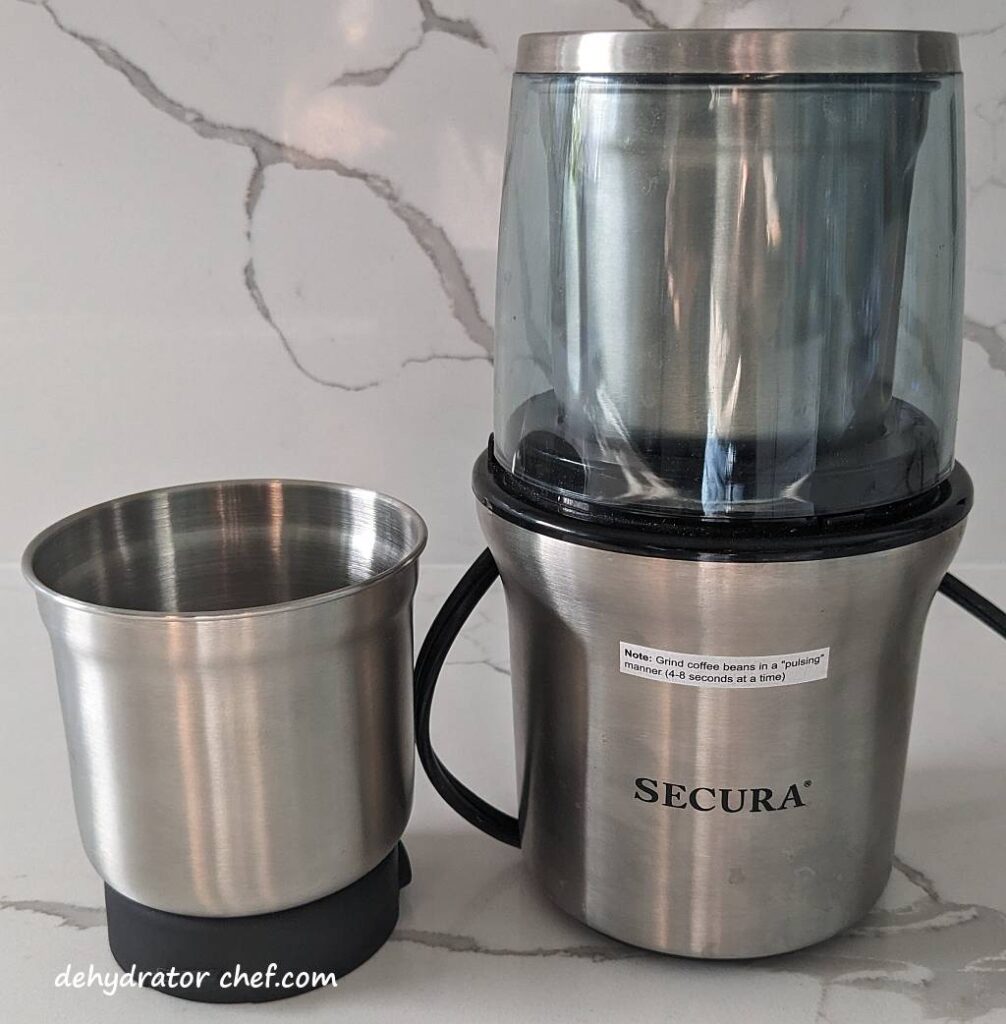
This is the spice grinder we use. It has over 4,000 customer reviews, with an average of 4.4 out of 5 stars. The spice grinder also comes with 2 removable stainless-steel bowls, a 2-blade grinder, and a 4-blade chopper. Cleaning out the ground spice residue from the removable bowls when you’re finished is super easy.
